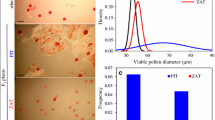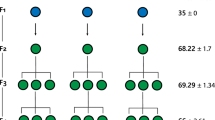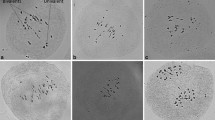Abstract
Meiosis in wide F1 hybrids in the tribe Triticeae is complex and irregular. Despite extensive research, the meiotic pathways in such hybrids remain largely unknown. In this study, the effect of the genotypes of disomic wheat–rye substitution lines on the regulation of meiosis in ABDR amphihaploids was analysed by comparing microsporogenesis and seed set under self pollination in hybrids of normal bread wheat (Triticum aestivum L.) and wheats with single chromosome substitutions 1R(1A), 1Rv(1A), 2R(2D)1, 2R(2D)2, 2R(2D)3, 5R(5D), 5R(5A), 6R(6A) with rye (Secale cereale L.). Three types of meiotic pathways were identified in the hybrids: reductional, equational, and equational+reductional. During the reductional type division, chromosomes randomly moved toward the poles at Anaphase I (AI) and separated sister chromatids at AII. Meiosis ended with tetrad formation, and the resulting plants were sterile ((2R(2D)1 × R, 2R(2D)2 × R). In the equational type division, the chromosomes aligned along the equator at Metaphase I and at AI separated into chromatids that moved toward the poles. This meiotic pathway led to dyad formation and partial fertility (especially in hybrids of 1Rv(1A) and 6R(6A)). In the equational+reductional pathway, some chromosomes divided in an equational manner while others were segregated reductionally within the same microsporocyte and this led to formation of tetrads with groups of uncoiled chromosomes. Comparison of the frequencies of each of the three meiotic pathways in different hybrid combinations suggests differences in contributions of individual chromosomes to the control of the entire meiotic process.






Similar content being viewed by others
References
Cai X, Xu SS, Zhu X (2010) Mechanism of haploidy-dependent unreductional meiotic cell division of polyploid wheat. Chromosoma 119:275–285
Chelysheva L, Diallo S, Vezon D, Cendrot G, Vrielynck N, Belcram K, Rocques N, Márquez-Lema A, Bhatt AM, Horlow C, Mercier R, Mézard C, Grelon M (2005) AtREC8 and AtSCC3 are essential to the monopolar orientation of the kinetochores during meiosis. J Cell Sci 118:4621–4632
d’Erfurth I, Jolivet S, Froger N, Catrice O, Novatchkova M, Mercier R (2009) Turning meiosis to mitosis. PLoS Biol. doi: 10.1371/journal.pbio.1000124
d’Erfurth I, Cromer L, Jolivet S, Girard C, Horlow C, Sun Y, To GPC, Berchowitz, Copenhaver G, Mercier R (2010) The CYCLIN-A CYCA1;2/TAM is required for the meiosis I to meiosis II transition and cooperates with OSD1 for the prophase to first meiotic division transition. PLoS Genet. doi:10.1371/journal.pgen.1000989
Fukuda K, Sakamoto S (1992) Cytological studies on reduced male gamete formation in hybrids between tetraploid emmer wheats and Aegilops squarrosa L. Jpn J Breed 42:255–266
Islam AKMR, Shepherd KW (1980) Meiotic restitution in wheat–barley hybrids. Chromosoma 79:363–372
Jenkins G, Phillips D, Mikhailova EI, Timopheeva L, Jones RN (2008) Meiotic genes and proteins in cereals. Cytogenet Genome Res 120:291–301
Maan SS, Sasakuma T (1977) Fertility of amphihaploids in Triticinae. J Hered 57:87–94
Matsuoka Y, Nasuda S (2004) Durum wheat as candidate for the unknown female progenitor of bread wheat: an empirical study with a highly fertile F1 hybrid with Aegilops tauschii Coss. Theor Appl Genet 109:1710–1717
Mercier R, Grelon M (2008) Meiosis in plants: ten years of gene discovery. Cytogenet Genome Res 120:281–290
Mok DWS, Peloquin SJ (1975) Three mechanisms of 2n pollen formation in diploid potatoes. Can J Genet Cytol 17:217–225. doi:10.1139/g75-029
Ramanna MS (1974) The origin of unreduced microspores due to aberrant cytokinesis in the meiocytes of potato and its genetic significance. Euphytica 23:20–30
Ramanna MS (1979) A re-examination of the mechanisms of 2n gamete formation in potato and its implications for breeding. Euphytica 28:537–561
Shchapova AI, Potapova TA, Kravtsova LA (1987) The genetical cause for chromosome non-segregation in meiosis of the wheat–rye polyhaploids. Genetika 23:473–481
Silkova OG, Shchapova AI, Kravtsova LA (2003) Mechanisms of meiotic restitution and their genetic regulation in wheat–rye polyhaploids. Rus J Genetics 39:1271–1280
Silkova OG, Dobrovolskaya OB, Dubovets NI, Adonina IG, Kravtsova LA, Roeder MS, Salina EA, Shchapova AI, Shumny VK (2006) Production of wheat–rye substitution lines and identification of chromosome composition of karyotypes using C-banding, GISH, and SSR markers. Rus J Genetics 42:645–653
Silkova OG, Dobrovolskaya OB, Dubovets NI, Adonina IG, Kravtsova LA, Shchapova AI, Shumny VK (2007a) Production of wheat–rye substitution lines based on winter rye cultivars with karyotype identification by means of C-banding, GISH, and SSR markers. Rus J Genetics 43:957–960
Silkova OG, Shchapova AI, Shumny VK (2007b) Role of rye chromosome 2R from wheat–rye substitution line 2R(2D)1 (Triticum aestivum L. cv. Saratovskaya 29–Secale cereale L. cv. Onokhoiskaya) in genetic regulation of meiotic restitution in wheat–rye polyhaploids. Rus J Genetics 43:805–814
Silkova OG, Dobrovolskaya OB, Shchapova AI, Shumny VK (2009) Features of the regulation of meiotic restitution in androgenic haploids of wheat–rye substitution lines 2R(2D)1, 2R(2D)3, and 6R(6A) (Triticum aestivum L., cultivar Saratovskaya29/Secale cereale L., cultivar Onokhoiskaya). Rus J Genetics 45:1062–1066
Wagenaar EB (1968a) Meiotic restitution and the origin of polyploidy. I. Influence of genotype on polyploid seedset in a Triticum crassum × Triticum turgidum hybrid. Can J Genet Cytol. 10: 836–843. doi:10.1139/g68-105
Wagenaar EB (1968b) Meiotic restitution and the origin of polyploidy. II. Prolonged duration of metaphaseI as causal factor of restitution induction. Can J Genet Cytol 10:844–852. doi:10.1139/g68-106
Xu SJ, Dong Y (1992) Fertility and meiotic mechanisms of hybrids between chromosome autoduplication tetraploid wheats and Aegilops species. Genome 35:379–384. doi:10.1139/g92-057
Xu SJ, Joppa LR (1995) Mechanisms and inheritance of first division restitution in hybrids of wheat, rye, and Aegilops squarrosa. Genome 38:607–615
Xu SJ, Joppa LR (2000) First division restitution in hybrids of Langdon durum disomic substitution linnes with rye and Aegilops squarrosa. Plant Breed 119:233–241
Zhang L, Yen Y, Zheng Y, Liu D (2007) Meiotic restriction in emmer wheat is controlled by one or more nuclear genes that continue to function in derived line. Sex Plant Reprod 20:159–166
Zhang L, Chen Q, Yuan Z, Xiang Z, Zheng Y, Liu D (2008) Production of aneuhaploid and euhaploid sporocytes by meiotic restitution in fertile hybrids between durum wheat Langdon chromosome substitution lines and Aegilops tauschii. J Genet Genomics 35:617–623
Acknowledgments
This work was supported by the Russian State Foundation for Basic Research (Project 10-04-00439-a) and Presidium of the Siberian Branch of the Russian Academy of Sciences (Project 129).
Author information
Authors and Affiliations
Corresponding author
Rights and permissions
About this article
Cite this article
Silkova, O.G., Shchapova, A.I. & Shumny, V.K. Patterns of meiosis in ABDR amphihaploids depend on the specific type of univalent chromosome division. Euphytica 178, 415–426 (2011). https://doi.org/10.1007/s10681-010-0325-6
Received:
Accepted:
Published:
Issue Date:
DOI: https://doi.org/10.1007/s10681-010-0325-6




